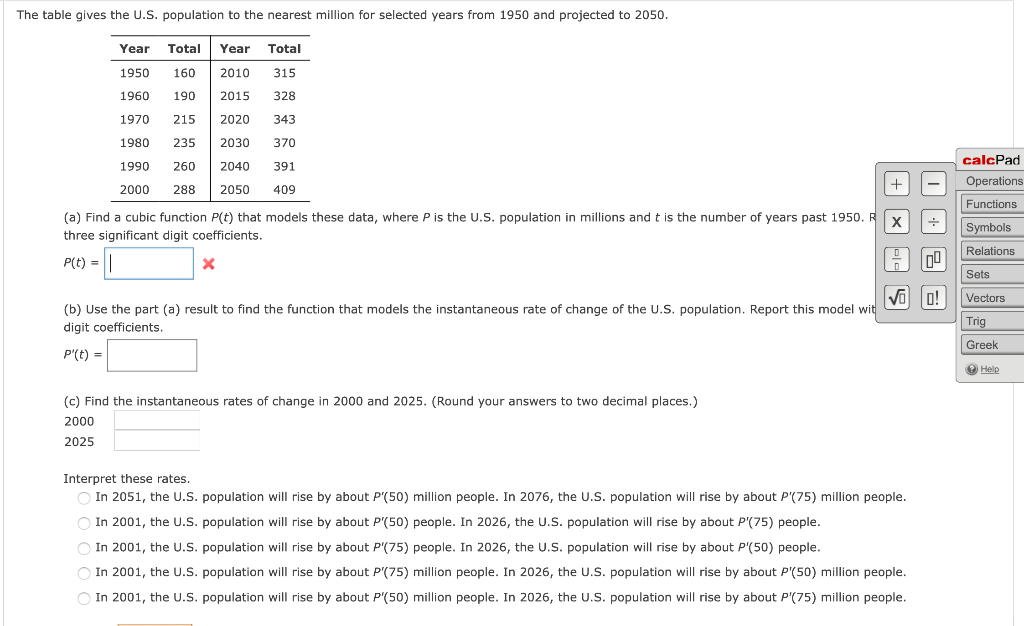The table gives the U.S. population to the nearest million for selected years from 1950 and projected to 2050. Year Total Year Total 1950 160 2010 315 1960 190 2015 328 1970 215 2020 343 1980 235 2030 370 1990 260 2040 391 2000 288 2050 409 (a) Find a cubic function P(t) that models these data, where P is the U.S. population in millions and t is the number of years past 1950. R three significant digit coefficients. P(t) = || Va o! (b) Use the part (a) result to find the function that models the instantaneous rate of change of the U.S. population. Report this model wit digit coefficients. P'(t) = (c) Find the instantaneous rates of change in 2000 and 2025. (Round your answers to two decimal places.) 2000 2025 Interpret these rates. O In 2051, the U.S. population will rise by about P'(50) million people. In 2076, the U.S. population will rise by about P'(75) million people. In 2001, the U.S. population will rise by about P'(50) people. In 2026, the U.S. population will rise by about P'(75) people. In 2001, the U.S. population will rise by about P'(75) people. In 2026, the U.S. population will rise by about P'(50) people. In 2001, the U.S. population will rise by about P'(75) million people. In 2026, the U.S. population will rise by about P'(50) million people. In 2001, the U.S. population will rise by about P'(50) million people. In 2026, the U.S. population will rise by about P'(75) million people. +
The table gives the U.S. population to the nearest million for selected years from 1950 and projected to 2050. Year Total Year Total 1950 160 2010 315 1960 190 2015 328 1970 215 2020 343 1980 235 2030 370 1990 260 2040 391 2000 288 2050 409 (a) Find a cubic function P(t) that models these data, where P is the U.S. population in millions and t is the number of years past 1950. R three significant digit coefficients. P(t) = || Va o! (b) Use the part (a) result to find the function that models the instantaneous rate of change of the U.S. population. Report this model wit digit coefficients. P'(t) = (c) Find the instantaneous rates of change in 2000 and 2025. (Round your answers to two decimal places.) 2000 2025 Interpret these rates. O In 2051, the U.S. population will rise by about P'(50) million people. In 2076, the U.S. population will rise by about P'(75) million people. In 2001, the U.S. population will rise by about P'(50) people. In 2026, the U.S. population will rise by about P'(75) people. In 2001, the U.S. population will rise by about P'(75) people. In 2026, the U.S. population will rise by about P'(50) people. In 2001, the U.S. population will rise by about P'(75) million people. In 2026, the U.S. population will rise by about P'(50) million people. In 2001, the U.S. population will rise by about P'(50) million people. In 2026, the U.S. population will rise by about P'(75) million people. +
Algebra & Trigonometry with Analytic Geometry
13th Edition
ISBN:9781133382119
Author:Swokowski
Publisher:Swokowski
Chapter3: Functions And Graphs
Section3.3: Lines
Problem 22E
Related questions
Question
Explanation all subparts is correctly

Transcribed Image Text:The table gives the U.S. population to the nearest million for selected years from 1950 and projected to 2050.
Year Total Year Total
1950
160
2010
315
1960
190
2015
328
1970
215
2020
343
1980
235
2030
370
calcPad
1990
260
2040
391
Operations
2000
288
2050
409
Functions
(a) Find a cubic function P(t) that models these data, where P is the U.S. population in millions and t is the number of years past 1950. R
Symbols
three significant digit coefficients.
Relations
P(t) = ||
Sets
VO o!
Vectors
(b) Use the part (a) result to find the function that models the instantaneous rate of change of the U.S. population. Report this model wit
Trig
digit coefficients.
Greek
P'(t) =
O Help
(c) Find the instantaneous rates of change in 2000 and 2025. (Round your answers to two decimal places.)
2000
2025
Interpret these rates.
O In 2051, the U.S. population will rise by about P'(50) million people. In 2076, the U.S. population will rise by about P'(75) million people.
In 2001, the U.S. population will rise by about P'(50) people. In 2026, the U.S. population will rise by about P'(75) people.
O In 2001, the U.S. population will rise by about P'(75) people. In 2026, the U.S. population will rise by about P'(50) people.
O In 2001, the U.S. population will rise by about P'(75) million people. In 2026, the U.S. population will rise by about P'(50) million people.
In 2001, the U.S. population will rise by about P'(50) million people. In 2026, the U.S. population will rise by about P'(75) million people.
Expert Solution
This question has been solved!
Explore an expertly crafted, step-by-step solution for a thorough understanding of key concepts.
This is a popular solution!
Trending now
This is a popular solution!
Step by step
Solved in 4 steps with 4 images

Recommended textbooks for you

Algebra & Trigonometry with Analytic Geometry
Algebra
ISBN:
9781133382119
Author:
Swokowski
Publisher:
Cengage

Algebra & Trigonometry with Analytic Geometry
Algebra
ISBN:
9781133382119
Author:
Swokowski
Publisher:
Cengage